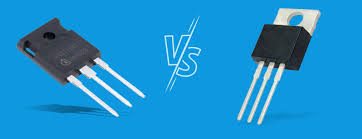Difference Between Transistor and Thyristor: A Complete Guide

Both transistors and thyristors are key components in electronic circuits, especially in systems that involve switching and amplification. While they may appear similar in some contexts, their structures, operating principles, and applications are quite different.
In this post, we’ll break down the core differences between a transistor and a thyristor, explore their uses in modern electronics, and help you decide which component is best suited for your project. Plus, we’ll link to where you can buy transistors, thyristors, and other semiconductors at DRex Electronics.

A transistor is a three-layer, three-terminal semiconductor device that can amplify signals or act as an electronic switch. It is widely used in analog and digital circuits.

Terminals: Emitter, Base, Collector (for BJT) / Source, Gate, Drain (for FET)
Control Mechanism: Controlled by continuous current or voltage applied to the base/gate
Operation Modes: Active, cutoff, saturation
Used For: Amplification, logic gates, power regulation, and switching


A thyristor, also known as a Silicon Controlled Rectifier (SCR), is a four-layer, three-terminal device primarily used for high-power switching in AC circuits.

Terminals: Anode, Cathode, Gate
Control Mechanism: Triggered by a single pulse to the gate
Operation: Latches ON until current drops below a threshold (holding current)
Used For: AC motor control, light dimmers, industrial power regulation


Feature
Transistor
Thyristor (SCR)
Layers
3 (NPN or PNP)
4 (PNPN)
Terminals
Emitter, Base, Collector
Anode, Cathode, Gate
Triggering Method
Requires continuous current or voltage input
Triggered by a single pulse
Function
Amplification and switching
Switching only
Current Control
Controlled by base/gate current or voltage
Conducts after trigger and continues until current stops
Switching Speed
Very fast (ns range)
Slower than transistors
Power Handling
Low to moderate power
High-power applications
Application Range
Logic circuits, amplifiers, digital systems
Motor drives, AC power control, light dimmers
Latch Behavior
No latch behavior (can be turned off via base control)
Latches ON until current stops

Transistor:
Dynamic control: You can turn it ON and OFF using a continuous signal.
Ideal for signal processing, analog circuits, and low-voltage switching.
Thyristor:
Latching behavior: Once turned on, it stays on until the current drops to zero.
Best for AC switching, industrial controls, and power regulation systems.

Application
Transistor Used?
Thyristor Used?
Audio Amplifier
Microcontroller Switching
AC Motor Speed Control
Power Supplies (DC-DC)
Light Dimmer (AC)
Inverters for Solar Systems

High-Voltage Rectification

At DRex Electronics, we provide:





While transistors and thyristors are both semiconductor switches, they serve different purposes in electronic systems. Transistors are perfect for fast, low-power control, while thyristors are ideal for high-voltage and high-current AC applications.
Whether you’re designing a microcontroller circuit or building a motor controller, choosing the right component is critical.

Visit DRex Electronics to explore and source top-quality transistors, thyristors, and other essential components.

